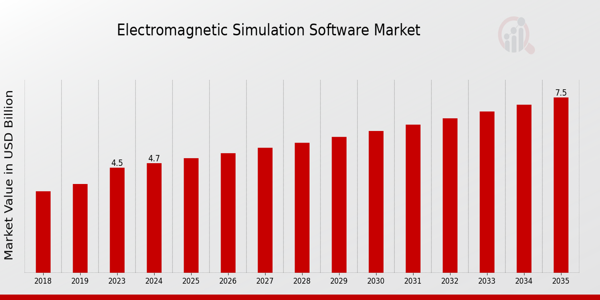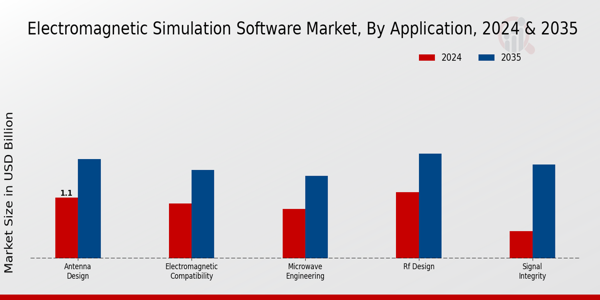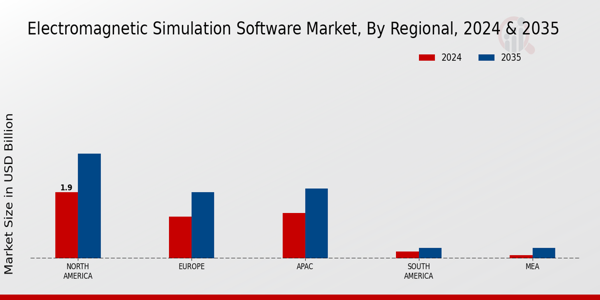Electromagnetic Simulation Software Market Overview
As per MRFR analysis, the Electromagnetic Simulation Software Market Size was estimated at 4.5 (USD Billion) in 2023. The Electromagnetic Simulation Software Market Industry is expected to grow from 4.7(USD Billion) in 2024 to 7.5 (USD Billion) by 2035. The Electromagnetic Simulation Software Market CAGR (growth rate) is expected to be around 4.34% during the forecast period (2025 - 2035).
Key Electromagnetic Simulation Software Market Trends Highlighted
The Global Electromagnetic Simulation Software Market is driven by the strong desire for sophisticated design tools across the telecommunications, automotive, and aerospace industries. The use of these simulation tools is growing due to the increased complexity of electronic devices and the efficiency requirements. The IoT and 5G technologies create an urgent need for precise electromagnetic modeling and analysis, which forces manufacturers to purchase simulation software to improve performance and regulatory compliance. In addition, there is an increasing shift from physical prototyping and testing to virtual modeling, which is changing how products are developed.
Numerous opportunities within this market can be explored further. The integration of artificial intelligence and machine learning with electromagnetic simulation could lead to enhanced capabilities, improving the speed and accuracy of simulations. This combination presents a chance for software developers to differentiate themselves and gain competitive advantages by offering tailored solutions that address specific industry needs. Additionally, expanding into emerging markets where technological advancements are gaining traction can open new revenue streams for existing and new players in the simulation software arena. In recent times, a noticeable trend is the shift toward cloud-based solutions, allowing for flexibility and scalability that traditional software cannot provide.
This trend supports remote collaboration, making it easier for global teams to work together on complex simulation tasks without geographical limitations. Additionally, the ongoing shift toward sustainable practices is pushing companies to utilize simulation software to optimize designs for energy efficiency and reduce environmental impact. These trends signal a progressive change in how electromagnetic simulation software is perceived and utilized across various sectors, pointing to a dynamic and evolving market landscape.

Source: Primary Research, Secondary Research, MRFR Database and Analyst Review
Electromagnetic Simulation Software Market Drivers
Growing Demand for Advanced Simulation Tools
The Global Electromagnetic Simulation Software Market Industry is witnessing a surge in demand for advanced simulation tools as industries strive to develop more efficient and innovative products. The increasing complexity of electromagnetic devices and systems primarily drives this demand. As technology advances, the need for rigorous testing and simulation becomes essential to ensure product performance, reliability, and compliance with regulatory standards.
Companies across sectors such as telecommunications, aerospace, automotive, and consumer electronics are investing in electromagnetic simulation software to decrease time-to-market and enhance product quality. Furthermore, the ability of these solutions to predict real-world scenarios and optimize designs before physical production significantly reduces resource waste and costs. The trend toward miniaturization and integration of electronic components into smaller devices further intensifies the need for sophisticated simulation software to address challenges related to electromagnetic interference and compatibility. This growing necessity for accurate and efficient simulation tools plays a pivotal role in propelling the Global Electromagnetic Simulation Software Market forward, promising robust growth in the coming years as more industries adapt to complex design requirements.
Rising Investment in R Activities
Investment in research and development activities is a significant driver for the Global Electromagnetic Simulation Software Market Industry. As companies continuously seek to innovate and differentiate their products, they are allocating substantial resources towards R&D. This emphasis on developing cutting-edge technologies necessitates sophisticated electromagnetic simulation tools that can accurately model and predict performance. Increased investment allows for enhanced software capabilities, integration with other engineering tools, and better user interfaces, making them more accessible to engineers and researchers. Consequently, this trend is expected to support overall market growth as businesses endeavor to improve product efficiencies and performance.
Expanding Applications Across Various Industries
The expanding range of applications for electromagnetic simulation software across various industries is a key driver of growth in the Global Electromagnetic Simulation Software Market Industry. With the evolution of technology, electromagnetic simulation tools are being utilized beyond traditional sectors, penetrating industries such as healthcare, renewable energy, and smart manufacturing. In healthcare, for instance, electromagnetic simulations play a crucial role in the design of medical devices such as MRI machines and wireless communication systems for telemedicine.
Similarly, in renewable energy, the software is essential for optimizing photovoltaic systems and wind turbines, ensuring efficiency in energy generation. This broadening scope not only enhances the software's relevance but also creates new opportunities for market expansion as more businesses recognize the value of these simulation tools in achieving operational excellence and innovation.
Electromagnetic Simulation Software Market Segment Insights
Electromagnetic Simulation Software Market Application Insights
The Global Electromagnetic Simulation Software Market, particularly the Application segment, plays a vital role in the infrastructure of modern technology, accounting for a market value of 4.7 USD Billion in 2024 and is expected to grow significantly by 2035. This segment encompasses various critical areas, each contributing to the market's overall dynamics. For instance, the Antenna Design segment holds a notable market share, valued at 1.1 USD Billion in 2024, and is projected to rise to 1.8 USD Billion in the following decade, underscoring its importance in the design and optimization of antennas that facilitate wireless communications.
Similarly, Electromagnetic Compatibility is another significant facet within this market, valued at 1.0 USD Billion in 2024, advancing to 1.6 USD Billion by 2035; its growth reflects the increasing need for devices to operate harmoniously in the presence of electromagnetic interference, crucial for product design in various industries. Microwave Engineering is also pivotal, with a valuation of 0.9 USD Billion in 2024, eventually reaching 1.5 USD Billion, highlighting its role in enabling high-frequency communication linkages essential for telecommunications and radar systems.
The RF Design segment, valued at 1.2 USD Billion in 2024 and anticipated to expand to 1.9 USD Billion by 2035, demonstrates its significance in the automotive and aerospace sectors, where radio frequency capabilities are critical. Finally, the Signal Integrity segment, although lower in valuation at 0.5 USD Billion in 2024 and poised to grow to 1.7 USD Billion, reflects the increasing demand for high-speed data communication and the need to preserve signal quality in complex electronic systems. These segments represent the diverse applications of electromagnetic simulation software, catering to a range of industries such as telecommunications, automotive, and consumer electronics, indicating a clear trend toward advanced electromagnetic solutions.
Technological advancements drive the overall market, the growing reliance on wireless communication, and the need for compliance with evolving standards in electromagnetic compatibility. The continuous evolution within this market presents ample opportunities for innovation and expansion, ultimately contributing to the comprehensive evolution of the Global Electromagnetic Simulation Software Market revenue as industries strive for technological excellence.

Source: Primary Research, Secondary Research, MRFR Database and Analyst Review
Electromagnetic Simulation Software Market End-Use Insights
The Global Electromagnetic Simulation Software Market is experiencing significant growth, particularly across various End Use applications. In 2024, the overall market market was valued at 4.7 billion USD, reflecting the rising demand for advanced simulation solutions. The Aerospace Defense sector is notably crucial, requiring precise electromagnetic performance analysis for communication systems and radar applications. Telecommunications is also a major contributor, driven by the need for enhanced network performance and next-generation communication technologies.
In the Automotive industry, the push for electric and autonomous vehicles creates opportunities for electromagnetic simulation to address design challenges and ensure system reliability. Consumer Electronics encompasses a wide range of products dependent on electromagnetic capabilities, where simulation software aids in optimizing device performance and compliance with regulatory standards. Additionally, the Healthcare sector utilizes these simulations for developing medical devices, ensuring safety and efficacy, thus holding a significant share of the market.Overall, with various sectors leveraging electromagnetic simulation for improved product development, efficiency, and compliance, the Global Electromagnetic Simulation Software Market reflects a dynamic and evolving landscape that showcases diverse applications across industries.
Electromagnetic Simulation Software Market Deployment Type Insights
The Global Electromagnetic Simulation Software Market encompasses various deployment types, including Cloud-Based, On-Premises, and Hybrid systems, each serving distinct user needs and preferences. The market reached a valuation of 4.7 billion USD by 2024, reflecting a growing demand for flexible and scalable solutions. Cloud-based deployment is gaining traction due to its accessibility, cost-effectiveness, and ease of integration, making it a preferred choice for many organizations looking to enhance collaboration and reduce infrastructure costs.
On-premises setups remain significant, particularly in industries where data security and compliance are paramount, allowing companies greater control over their sensitive information. The Hybrid approach combines the best of both worlds, providing the advantages of cloud flexibility and on-premises security, thus appealing to businesses with diverse operational needs. These deployment types play a crucial role in the Global Electromagnetic Simulation Software Market segmentation, responding to market growth fueled by advancements in computational capabilities and increasing demands for simulation accuracy in various industrial applications. As a result, they shape market trends, presenting opportunities for innovation and expansion in emerging technologies while addressing challenges related to interoperability and user adoption.
Electromagnetic Simulation Software Market Software Type Insights
The Global Electromagnetic Simulation Software Market, with a revenue of 4.7 USD Billion in 2024, is experiencing robust growth driven by the increasing demand for advanced modeling technologies across various industries. Within this market, the Software Type segment is vital, encompassing categories such as 3D Electromagnetic Simulation Software, 2D Electromagnetic Simulation Software, and Field Solver Software. 3D Electromagnetic Simulation Software is essential due to its ability to provide detailed and accurate representations, thus playing a crucial role in the design and testing of complex systems.
Meanwhile, 2D Electromagnetic Simulation Software holds significant importance for less complex applications, often utilized for preliminary designs and simpler projects. Field Solver Software dominates by offering powerful numerical techniques to solve electromagnetic problems, making it invaluable for engineers and researchers in optimizing their designs. As industries continue to innovate and evolve, the segmentation within the Global Electromagnetic Simulation Software Market will cater to diverse needs and utilize technology advancements to enhance performance and accuracy.Overall, the market continues to adapt to emerging trends, with ongoing opportunities on the horizon.
Electromagnetic Simulation Software Market Regional Insights
The Global Electromagnetic Simulation Software Market shows promising growth across various regional segments, with North America holding a majority share valued at 1.9 USD Billion in 2024 and projected to reach 3.0 USD Billion by 2035. This dominance is driven by the strong presence of technology companies and increasing demand for advanced simulation tools in industries like telecommunications and aerospace. Europe follows with a significant market value of 1.2 USD Billion in 2024 and a projected increase to 1.9 USD Billion by 2035, benefiting from ongoing innovations in electronic design and manufacturing.
The APAC region, valued at 1.3 USD Billion in 2024, is expected to grow to 2.0 USD Billion by 2035, propelled by expanding electronics and telecommunications sectors. South America and MEA contribute smaller figures, with South America valued at 0.2 USD Billion and MEA at 0.1 USD Billion in 2024, both showing potential for growth as local industries adopt more simulation technologies. This market segmentation highlights a diverse regional landscape where each area faces unique challenges and opportunities, ultimately influencing the overall Global Electromagnetic Simulation Software Market revenue and growth trajectory.

Source: Primary Research, Secondary Research, MRFR Database and Analyst Review
Electromagnetic Simulation Software Market Key Players and Competitive Insights:
A diverse range of players characterizes the Global Electromagnetic Simulation Software Market, each offering unique solutions to various sectors such as telecommunications, automotive, aerospace, and electronics. As industries increasingly rely on precise electromagnetic analysis to enhance product design, optimize performance, and ensure regulatory compliance, the demand for sophisticated simulation tools has surged. This competitive landscape is influenced by rapid technological advancements, growing investments in RD, and the need for simulation accuracy. In this market, players are striving not only to improve their computational algorithms but also to enhance user experience through more intuitive interfaces and robust customer support. The interplay of these factors is driving innovation, leading to the introduction of new features and services that cater to the evolving needs of users across different sectors.
OptiFDTD stands out in the Global Electromagnetic Simulation Software Market through its strong focus on fast and accurate solutions tailored for various electromagnetic analysis applications. The software is particularly known for its robust finite-difference time-domain (FDTD) method, which allows engineers and designers to tackle complex problems efficiently. One of OptiFDTD's key strengths is its capability to simulate a wide range of frequencies and materials, which is essential for applications in RF and microwave engineering. This adaptability, along with a user-friendly interface, guides users through various simulation processes seamlessly. Furthermore, the continuous updates and enhancements to the software ensure that OptiFDTD remains effective in addressing the latest challenges posed by advancements in technology, making it a preferred choice among professionals in fields demanding high fidelity in electromagnetic performance predictions.
AWR Corporation possesses a strong presence in the Global Electromagnetic Simulation Software Market, particularly recognized for its in-depth capabilities in circuit simulation and RF design. The company's flagship product, which integrates both circuit and electromagnetic simulation, exemplifies how AWR Corporation leverages synergistic design approaches to enhance workflow efficiency. A notable strength of AWR Corporation is its commitment to user engagement through comprehensive training and customer support services, which enables users to maximize the potential of their software tools. Additionally, AWR Corporation emphasizes the seamless integration of its tools with other industry-standard software, which facilitates easier collaboration and data sharing among teams. The company's focus on evolving its simulation capabilities to incorporate advanced technologies ensures it stays competitive and can meet the increasingly sophisticated demands of the market.
Key Companies in the Electromagnetic Simulation Software Market Include
- OptiFDTD
- AWR Corporation
- Magee Scientific
- Sonnet Software
- COMSOL
- Rohde and Schwarz
- Altair Engineering
- Electromagnetic Applications
- Lumerical
- Texas Instruments
- CST Studio Suite
- Keysight Technologies
- EMsoft
- HFSS
- ANSYS
Electromagnetic Simulation Software Market Industry Developments
Recent developments in the Global Electromagnetic Simulation Software Market indicate significant advancements and growing competition among prominent companies such as COMSOL, Keysight Technologies, and ANSYS. The demand for electromagnetic simulation tools is steadily increasing due to the expanding applications in industries like telecommunications, automotive, and aerospace. Notably, COMSOL introduced new features in its Multiphysics simulation software, enhancing its capabilities for complex modeling. Additionally, Keysight Technologies is focusing on enhancing simulation accuracy for 5G applications, which is a crucial trend driving growth in market valuation. Companies like Altair Engineering and AWR Corporation are also innovating to provide more integrated solutions to meet the increasing complexity of electromagnetic design challenges. On the MA front, there have been notable consolidations; for example, the acquisition of Sonnet Software by a strategic partner has been highlighted as a move to broaden its service offerings and customer base. Furthermore, Texas Instruments is expanding its electromagnetic simulation tools in alignment with its development of RF components. Overall, the market dynamics reflect a combination of technological advancements and strategic partnerships aimed at enhancing the capabilities and reach of electromagnetic simulation software providers.
Electromagnetic Simulation Software Market Segmentation Insights
Electromagnetic Simulation Software Market Application Outlook
- Antenna Design
- Electromagnetic Compatibility
- Microwave Engineering
- RF Design
- Signal Integrity
Electromagnetic Simulation Software Market End-Use Outlook
- Aerospace Defense
- Telecommunications
- Automotive
- Consumer Electronics
- Healthcare
Electromagnetic Simulation Software Market Deployment Type Outlook
- Cloud-Based
- On-Premises
- Hybrid
Electromagnetic Simulation Software Market Software Type Outlook
- 3D Electromagnetic Simulation Software
- 2D Electromagnetic Simulation Software
- Field Solver Software
Electromagnetic Simulation Software Market Regional Outlook
- North America
- Europe
- South America
- Asia-Pacific
- Middle East and Africa
| Attribute/Metric Source: |
Details |
| MARKET SIZE 2023 |
4.5(USD Billion) |
| MARKET SIZE 2024 |
4.7(USD Billion) |
| MARKET SIZE 2035 |
7.5(USD Billion) |
| COMPOUND ANNUAL GROWTH RATE (CAGR) |
4.34% (2025 - 2035) |
| REPORT COVERAGE |
Revenue Forecast, Competitive Landscape, Growth Factors, and Trends |
| BASE YEAR |
2024 |
| MARKET FORECAST PERIOD |
2025 - 2035 |
| HISTORICAL DATA |
2019 - 2024 |
| MARKET FORECAST UNITS |
USD Billion |
| KEY COMPANIES PROFILED |
OptiFDTD, AWR Corporation, Magee Scientific, Sonnet Software, COMSOL, Rohde and Schwarz, Altair Engineering, Electromagnetic Applications, Lumerical, Texas Instruments, CST Studio Suite, Keysight Technologies, EMsoft, HFSS, ANSYS |
| SEGMENTS COVERED |
Application, End Use, Deployment Type, Software Type, Regional |
| KEY MARKET OPPORTUNITIES |
5G technology advancements, Autonomous vehicle design needs, Increasing IoT applications, Rising demand for wireless communication, Growth in aerospace and defense sectors |
| KEY MARKET DYNAMICS |
Increasing demand for electronic devices, Advancements in simulation technologies, Rise in R&D investments, Growing need for efficient designs, Surge in automation and AI integration |
| COUNTRIES COVERED |
North America, Europe, APAC, South America, MEA |
Frequently Asked Questions (FAQ) :
The Electromagnetic Simulation Software Market was valued at 4.7 USD Billion in 2024.
The expected CAGR for the Electromagnetic Simulation Software Market from 2025 to 2035 is 4.34%.
The Antenna Design application segment is expected to be valued at 1.8 USD Billion in 2035.
The RF Design application segment is projected to grow from 1.2 USD Billion in 2024 to 1.9 USD Billion in 2035.
The market size for the APAC region is expected to reach 2.0 USD Billion by 2035.
Key players in the market include companies such as OptiFDTD, AWR Corporation, and COMSOL, among others.
The Signal Integrity application is expected to be valued at 1.7 USD Billion in 2035.
The MEA region is expected to grow from 0.1 USD Billion in 2024 to 0.3 USD Billion in 2035.
















